Revisiting Blasius Flow by Fixed Point Method
Abstract
The well-known Blasius flow is governed by a third-order nonlinear ordinary differential equation with two-point boundary value. Specially, one of the boundary conditions is asymptotically assigned on the first derivative at infinity, which is the main challenge on handling this problem. Through introducing two transformations not only for independent variable bur also for function, the difficulty originated from the semi-infinite interval and asymptotic boundary condition is overcome. The deduced nonlinear differential equation is subsequently investigated with the fixed point method, so the original complex nonlinear equation is replaced by a series of integrable linear equations. Meanwhile, in order to improve the convergence and stability of iteration procedure, a sequence of relaxation factors is introduced in the framework of fixed point method and determined by the steepest descent seeking algorithm in a convenient manner.
1. Introduction
As known, no simple closed-form solution to the Blasius problem is available, despite the simple form and such a long history of it since 1908 [3]. Much attention has been paid to this problem. Blasius [3] himself firstly investigated this problem by the perturbation method and obtained an approximate solution by matching a power series solution for small η to an asymptotic expansion for large η. However, this procedure may be improper because of somewhat restricted radius of convergence in the first power series [8]. Later, this problem was handled by Bender et al. [9] with δ-expansion in a smart manner. The approximate solutions were obtained by He [10], Liao [11, 12], and Turkyilmazoglu [13–16] with the variational iteration method, homotopy analysis method, and homotopy perturbation method, respectively. Wang [17] also investigated this problem by the Adomian decomposition method. Meantime, there are a lot of numerical methods emerging to handle the Blasius problem including, but not limited to, shooting method, finite differences method, and spectral method [18–31]. A vast bibliography of numerical methods has developed for this problem, so a full account of them is out of the scope of this paper, and readers are suggested to refer to the review articles [6, 7]. It is noted that the existing numerical methods usually integrate this problem over a finite interval η ∈ [0, η∞], although the Blasius problem is originally defined on the semi-infinite interval η ∈ [0, +∞). Thus the value of η∞ should be chosen sufficiently large to assure the accuracy of the asymptotical boundary condition at infinity. However, the appropriate value η∞ could not be determined beforehand, so usually the trial-and-error approach is involved, and some different values should be tried to find the appropriate η∞ to satisfy the demanded accuracy.
In order to exactly assure the boundary conditions (2) and obtain a uniformly valid solution on the semi-infinite interval η ∈ [0, +∞), two transformations not only for the independent variable η but also for function f(η) are introduced in this paper. The transformed nonlinear differential equation is subsequently investigated with the fixed point method (FPM) [33], which transforms the nonlinear differential equation into a series of integrable linear differential equations. Hence, an approximate semianalytical solution to the Blasius problem is finally obtained, which is valid on the whole domain and can satisfy the asymptotic property automatically. Meantime, in order to improve the convergence and stability of iteration procedure, a sequence of relaxation factors is introduced in the framework of FPM, which are determined by the steepest descent seeking algorithm. Thus, the accuracy of this approximate solution could be improved step by step in a convenient manner.
2. Revisiting the Blasius Equation by Fixed Point Method
2.1. Transformations
2.2. The Idea of Fixed Point Method (FPM)
The fixed point, a fundamental concept in functional analysis [34], has been widely adopted in studying the existence and uniqueness of solutions by pure mathematicians. Recently, the fixed point concept has been used to handle nonlinear differential equations, and the fixed point method (FPM) has been proposed to obtain the explicit approximate analytical solution to the nonlinear differential equation [33].
In [33], only one relaxation factor ϖ is introduced and determined by the so-called ϖ-curves in a heuristic manner. Here, a sequence of relaxation factors {ϖn | n = 1,2, 3, …} is introduced in (12), which will be decided according to the steepest descent seeking algorithm in the following Section 2.3.
2.3. The Steepest Descent Seeking Algorithm (SDS)
As mentioned in Section 2.2, the relaxation factor {ϖn|n = 1,2, 3, …} could improve the convergence and stability of iteration procedure, and usually the optimal value of relaxation factor is dependent on the problem to be solved. Here, an algorithm, named as the steepest descent seeking algorithm (SDS), is adopted to determine the optimal value of the relaxation factor.
The name of the steepest descent seeking algorithm just comes from the aforementioned approach; that is, every optimal value ϖn,opt is sought to minimize the corresponding square residual error Resn. According to this approach, only one nonlinear algebraic equation should be solved in every iteration step, and the elements of the sequence {ϖn|n = 1,2, 3, …} are obtained sequentially and separately.
2.4. Iteration Procedure
3. Result and Discussion
3.1. Results as λ = 1/5
Before the acquirement of approximate solution according to the iteration procedure (21), the free parameter λ should be determined. It is found that the iteration procedure converges rapidly when the value of 1/λ takes the scale of boundary layer thickness. Here, the value of λ is firstly set to λ = 1/5 and the influence of λ value on the solution will be studied in Section 3.2.
For the higher-order approximation gn(z), the procedure is similar, and an explicit semianalytical solution could be deduced by the symbolic computation software, such as MAXIMA, MAPLE and MATHEMATICA.
The convergence history of the square residual error Resn is illustrated in Figure 1, which clearly shows that Resn is gradually reduced during the iteration procedure, so the accuracy of the approximate solution could be improved step by step to any possibility.
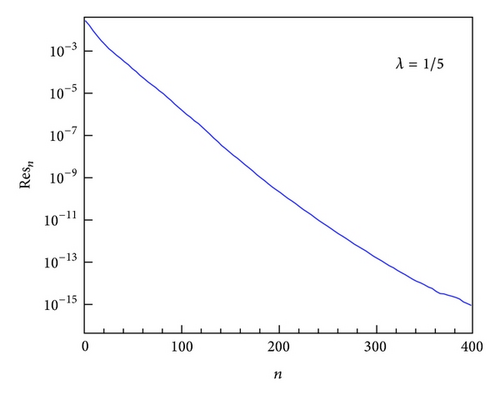
| Present (FPM) | Fazio [31] |
Zhang and Chen [32] | Boyd [6, 7] (Benchmark) | |
|---|---|---|---|---|
| n | ||||
| 1 | 0.3399132521631 | 0.3320575595 | 0.33205733621 | 0.33205733621519630 |
| 25 | 0.3314634706964 | |||
| 50 | 0.3322299008614 | |||
| 100 | 0.3320852976636 | |||
| 150 | 0.3320560696476 | |||
| 200 | 0.3320572413724 | |||
| 250 | 0.3320573781489 | |||
| 300 | 0.3320573415043 | |||
| 400 | 0.3320573362780 | |||
| 600 | 0.3320573362198 | |||
| 800 | 0.3320573362153 | |||
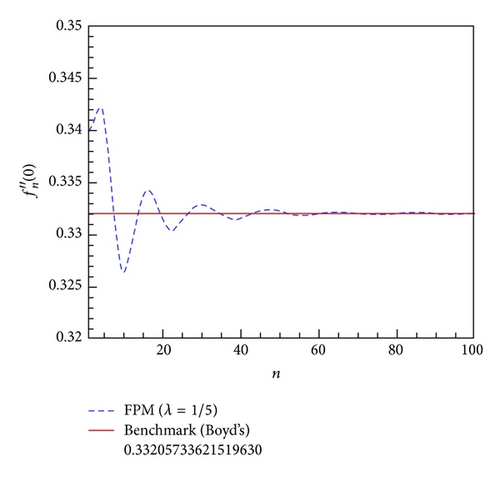
The approximate semianalytical solutions and the well-known Howarth’s [32] accurate numerical result of f(η), f′(η), and f′′(η) are compared in Figure 3 and simultaneously tabulated in Tables 2–4, which shows that the present result obtained by FPM is of high accuracy.
| η | f | |||
|---|---|---|---|---|
| FPM | Howarth [21] |
|||
| n = 50 | n = 200 | n = 800 | ||
| 0 | 0. | 0. | 0. | 0 |
| 0.2 | 0.006644529362447 | 0.006640995986591 | 0.006640999714597 | 0.00664 |
| 0.4 | 0.02657431250127 | 0.02655986911996 | 0.02655988401799 | 0.02656 |
| 0.6 | 0.05976777037563 | 0.05973460409079 | 0.05973463749804 | 0.05974 |
| 0.8 | 0.1061682229933 | 0.1061081617252 | 0.1061082208390 | 0.10611 |
| 1.0 | 0.1656669946990 | 0.1655716339700 | 0.1655717257893 | 0.16557 |
| 1.2 | 0.2380877115384 | 0.2379485860317 | 0.2379487172889 | 0.23795 |
| 1.4 | 0.3231726092163 | 0.3229813967422 | 0.3229815738295 | 0.32298 |
| 1.6 | 0.4205717973682 | 0.4203205366053 | 0.4203207655016 | 0.42032 |
| 1.8 | 0.5298364510983 | 0.5295177515398 | 0.5295180377438 | 0.52952 |
| 2 | 0.6504167979655 | 0.6500240214585 | 0.6500243699353 | 0.65003 |
| 3 | 1.397637112752 | 1.396807516637 | 1.396808230870 | 1.39682 |
| 4 | 2.307039632340 | 2.305745294404 | 2.305746418462 | 2.30576 |
| 5 | 3.284986166454 | 3.283272129531 | 3.283273665156 | 3.28329 |
| 6 | 4.281691879364 | 4.279618989982 | 4.279620922514 | 4.27964 |
| 7 | 5.281627551984 | 5.279236492841 | 5.279238811029 | 5.27926 |
| 8 | 6.281851614090 | 6.279210729689 | 6.279213431346 | 6.27923 |
| 10 | 8.282182252512 | 8.279208870686 | 8.279212342934 | / |
| 15 | 13.284515240195 | 13.27920694573 | 13.279212342479 | / |
| 20 | 18.283646215099 | 18.27920502276 | 18.279212342479 | / |
| η | f′ | |||
|---|---|---|---|---|
| FPM | Howarth [21] |
|||
| n = 50 | n = 200 | n = 800 | ||
| 0 | 0. | 0. | 0. | 0 |
| 0.2 | 0.06644347995228 | 0.06640775477474 | 0.06640779209625 | 0.06641 |
| 0.4 | 0.1328378289536 | 0.1327640864649 | 0.1327641607610 | 0.13277 |
| 0.6 | 0.1990509318305 | 0.1989371417431 | 0.1989372524222 | 0.19894 |
| 0.8 | 0.2648643497350 | 0.2647089925007 | 0.2647091387231 | 0.26471 |
| 1.0 | 0.3299775414929 | 0.3297798506391 | 0.3297800312497 | 0.32979 |
| 1.2 | 0.3940157297864 | 0.3937758909492 | 0.3937761044339 | 0.39378 |
| 1.4 | 0.4565422496657 | 0.4562615202332 | 0.4562617647051 | 0.45627 |
| 1.6 | 0.5170757864638 | 0.5167565112060 | 0.5167567844226 | 0.51676 |
| 1.8 | 0.5751123265865 | 0.5747578444754 | 0.5747581438894 | 0.57477 |
| 2 | 0.6301509546266 | 0.6297654136655 | 0.6297657365024 | 0.62977 |
| 3 | 0.8465117311855 | 0.8460440464746 | 0.8460444436580 | 0.84605 |
| 4 | 0.9559675373580 | 0.9555178143322 | 0.9555182298107 | 0.95552 |
| 5 | 0.9919283302451 | 0.9915414951870 | 0.9915419001644 | 0.99155 |
| 6 | 0.9993091537696 | 0.9989724827440 | 0.9989728724358 | 0.99898 |
| 7 | 1.000215077512 | 0.9999212208137 | 0.9999216041479 | 0.99992 |
| 8 | 1.000195058002 | 0.9999958903313 | 0.9999962745353 | 1.00000 |
| 10 | 1.000231913519 | 0.9999996129000 | 0.9999999980154 | / |
| 15 | 1.000224523350 | 0.9999996133026 | 1.000000000000 | / |
| 20 | 0.9997789079310 | 0.9999996166005 | 1.000000000000 | / |
| η | f′′ | |||
|---|---|---|---|---|
| FPM | Howarth [21] | |||
| n = 50 | n = 200 | n = 800 | ||
| 0 | 0.3322299008614 | 0.3320572413724 | 0.33205733621526 | 0.33206 |
| 0.2 | 0.3321681255428 | 0.3319836510534 | 0.33198383711462 | 0.33199 |
| 0.4 | 0.3316651431123 | 0.3314696606323 | 0.33146984420144 | 0.33147 |
| 0.6 | 0.3302835149673 | 0.3300789475208 | 0.33007912757428 | 0.33008 |
| 0.8 | 0.3275995678839 | 0.3273890950354 | 0.32738927014924 | 0.32739 |
| 1.0 | 0.3232190113859 | 0.3230069482211 | 0.32300711668693 | 0.32301 |
| 1.2 | 0.3167975457228 | 0.3165890310990 | 0.31658919106110 | 0.31659 |
| 1.4 | 0.3080647180157 | 0.3078652421801 | 0.30786539179016 | 0.30787 |
| 1.6 | 0.2968484699253 | 0.2966633238744 | 0.29666346145571 | 0.29667 |
| 1.8 | 0.2830971363448 | 0.2829308930580 | 0.28293101725975 | 0.28293 |
| 2 | 0.2668953087923 | 0.2667514357803 | 0.26675154569727 | 0.26675 |
| 3 | 0.1613836232798 | 0.1613602778747 | 0.16136031954088 | 0.16136 |
| 4 | 0.06418469140538 | 0.06423412147661 | 0.064234121091696 | 0.06424 |
| 5 | 0.01584093436570 | 0.01590681516643 | 0.015906798685320 | 0.01591 |
| 6 | 2.367987742194e − 3 | 2.402051505611e − 3 | 2.4020398437568e − 3 | 0.00240 |
| 7 | 1.526040209602e − 4 | 2.201705391867e − 4 | 2.201689552708e − 4 | 0.00022 |
| 8 | −9.161215077567e − 4 | 1.223887615942e − 5 | 1.224092624324e − 5 | 0.00001 |
| 10 | 1.667970449293e − 4 | 9.650715210973e − 9 | 8.442915877193e − 9 | / |
| 15 | 2.499528919705e − 4 | −1.207941083287e − 10 | 1.426848065722e − 17 | / |
| 20 | 1.244076430614e − 4 | 1.815564827202e − 9 | 4.736242910970e − 18 | / |
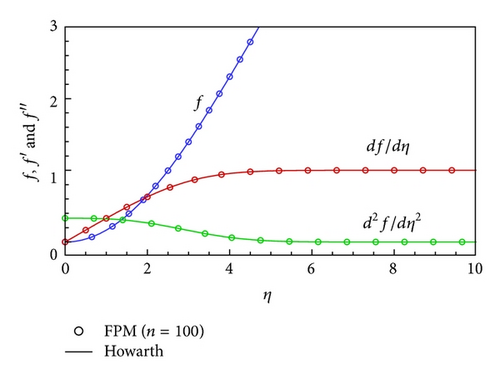
The residual error function is plotted in Figure 4, which also reveals that the error of approximate solutions gradually decreases during the iteration procedure. Moreover, the present approximate solutions are uniformly valid in the whole region.
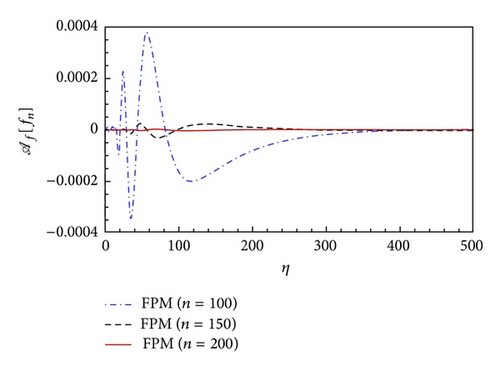
| η | f − η | (Benchmark) [6, 7] |
|---|---|---|
| 5 | −1.716726334844 | −1.720787657520503 |
| 6 | −1.720379077486 | |
| 7 | −1.720761188971 | |
| 8 | −1.720786568654 | |
| 9 | −1.720787629355 | |
| 10 | −1.720787657066 | |
| 11 | −1.720787657516 | |
| 12 | −1.720787657520 | |
| 13 | −1.720787657521 | |
| 14 | −1.720787657521 | |
| 15 | −1.720787657521 | |
| 20 | −1.720787657521 | |
| 25 | −1.720787657521 | |
| 30 | −1.720787657521 |
3.2. The Influence of λ Value on the Solution
It is clear that 1/λ takes the length dimension in consideration of transformation (6). In order to investigate the influence of λ value on the solution, some different λ values are considered in the following calculations, and the comparison of Resn at different λ values is displayed in Figures 5(a) and 5(b). It is found that all Resn corresponding to different λ values are gradually reduced during the iteration procedure, and Resn based on λ = 1/5 converges more rapidly than others. What is the physical meaning of λ? Let us try to find the answer from the Prandtl’s boundary layer theory [5].

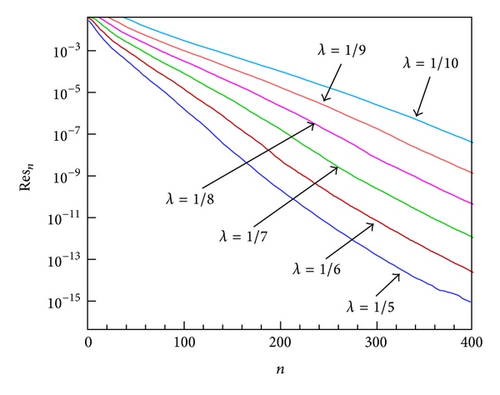
According to Prandtl’s boundary layer theory, the effect of viscosity is mainly confined to the boundary layer such that η < δ, and the outer flow (η > δ) could be considered as inviscid flow. From Table 3, the thickness of the boundary layer is just about δ ≈ 5, where u/U∞ = f′ ≈ 0.99. Now, the physical meaning of λ becomes clear. 1/λ has the same scale of boundary layer thickness δ. In consideration of transformation (6), the region −1 ≤ z ≤ 1 is divided into two equal parts, and the viscous flow (η < δ ≈ 5) and inviscid flow (η > δ ≈ 5) correspond to −1 ≤ z < 0 and 0 < z < 1, respectively. Although this determination of λ is in a heuristic manner, it is fortunate that the solution is quite insensitive to λ so long as 1/λ is of the same order-of-magnitude as δ ≈ 5. The influence of λ on the convergence of is given in Figures 6(a) and 6(b), which also reveals that the limit values of with different λ values agree well with each other. Hence, the selection of λ is nonessential to the final solution.
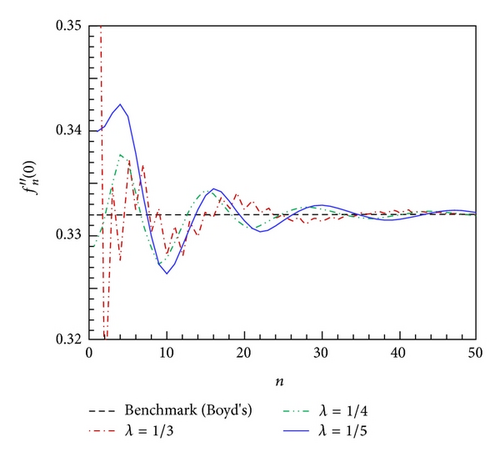
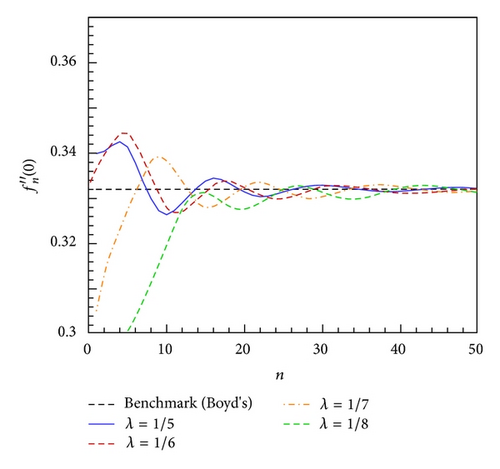
4. Conclusion
In this paper, the well-known Blasius flow is revisited by the fixed point method (FPM). In order to overcome the difficulties originated from the semi-infinite interval and asymptotic boundary condition, two transformations are introduced for not only the independent variable but also the dependent variable. Under these transformations, all the boundary conditions are exactly assured for every order approximate solution. In the meanwhile, a free scale parameter λ is introduced in the transformation, and its physical meaning is related to the thickness of the boundary layer. Moreover, a sequence of relaxation factors {ϖn | n = 1,2, 3, …} is introduced to improve the convergence and stability during iteration procedure, and its elements are obtained in a convenient manner by the steepest descent seeking algorithm. Finally, the comparison of the present results with other scholars’ numerical results, especially with the benchmarking results provided by Boyd, shows that FPM is an effective and accurate approach to obtain the semianalytical solution to nonlinear problems.
Nomenclature
-
- U∞:
-
- Free stream velocity, m/s
-
- u:
-
- x-components of the velocity, m/s
-
- v:
-
- y-components of the velocity, m/s
-
- ψ(x, y):
-
- Stream function, m2/s
-
- f(η):
-
- Nondimensional stream function
-
- ν:
-
- Kinematic viscosity coefficient, m2/s.
Conflict of Interests
The authors declare that there is no conflict of interests regarding the publication of this paper.
Acknowledgments
The work is supported by the National Natural Science Foundation of China (Approval no. 11102150) and the Fundamental Research Funds for the Central Universities.




